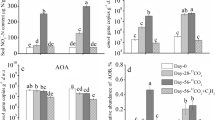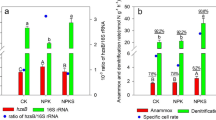Abstract
Purpose
Aerobic ammonia oxidation often couples with anaerobic ammonium oxidation (anammox) in natural ecosystems; however, their in situ activities and relative contributions are still unclear.
Methods
We evaluated in situ activities of both processes in the water-soil interface, bulk, and rhizosphere regions of paddy soil by 15N stable isotope.
Results
At the interface, we only detected aerobic ammonia oxidation activities (RA, 6.06 mmol L−1 d−1), and RA was significantly higher than in the other two regions. In the bulk soil, the RA and anammox activities (RAn) were 0.87 and 1.84 mmol L−1 d−1, respectively. In the rhizosphere soil, the RA and RAn were 0.92 and 1.17 mmol L−1 d−1, respectively. Aerobic ammonia oxidation contributed 7.0%, 5.9%, and 3.9% to the total ammonium consumption in the interface, bulk, and rhizosphere regions, respectively, while anammox contributed 13.3% and 5.3% in the bulk and rhizosphere regions, respectively. RA and RAn were positively correlated with transcript abundances of amoA and hzsB genes, respectively, rather than gene abundances. Moreover, dissolved oxygen (DO) was the most critical factor statistically influencing RA and RAn, while dissolved organic carbon (DOC) and total organic carbon (TOC) was also correlated with RAn.
Conclusion
Overall, we demonstrated that in situ aerobic ammonia oxidation in the interface and rhizosphere regions was more active than in the bulk soil, whereas in situ anammox was more active in the bulk soil. This study provides an increased understanding of the in situ distribution and contributions of aerobic ammonia oxidation and anammox co-occurring in complex ecosystems.




Similar content being viewed by others
References
Armstrong W (1980) Aeration in higher plants. Adv Bot Res 7:225–332
Bai R, ** D, He JZ, Hu HW, Fang YT, Zhang LM (2015) Activity, abundance and community structure of anammox bacteria along depth profiles in three different paddy soils. Soil Biol Biochem 91:212–221
Baolan H, Shuai L, Wei W, Lidong S, Li** L, Wei** L, Guangming T, **angyang X, ** Z (2014) pH-dominated niche segregation of ammonia-oxidising microorganisms in Chinese agricultural soils. FEMS Microbiol Ecol 90:290–299
Briones AM, Okabe S, Umemiya Y, Ramsing NB, Reichardt W, Okuyama H (2003) Ammonia-oxidizing bacteria on root biofilms and their possible contribution to N use efficiency of different rice cultivars. Plant Soil 250:335–348
Cui S, Shi Y, Groffman PM, Schlesinger WH, Zhu YG (2013) Centennial-scale analysis of the creation and fate of reactive nitrogen in China (1910-2010). Proc Natl Acad Sci 110:2052–2057
Dennis PG, Miller AJ, Hirsch PR (2010) Are root exudates more important than other sources of rhizodeposits in structuring rhizosphere bacterial communities? FEMS Microbiol Ecol 72:313–327
Ding LJ, An XL, Li S, Zhang GL, Zhu YG (2014) Nitrogen loss through anaerobic ammonium oxidation coupled to iron reduction from paddy soils in a chronosequence. Environ Sci Technol 48:10641–10647
Feng Y, Sun H, Xue L, Liu Y, Gao Q, Lu K, Yang L (2017) Biochar applied at an appropriate rate can avoid increasing NH 3 volatilization dramatically in rice paddy soil. Chemosphere 168:1277–1284
Francis CA, Roberts KJ, Beman JM, Santoro AE, Oakley BB (2005) Ubiquity and diversity of ammonia-oxidizing archaea in water columns and sediments of the ocean. Proc Natl Acad Sci 102:14683–14688
Freitag TE, Prosser JI (2003) Community structure of Ammonia-oxidizing Bacteria within anoxic marine sediments. Appl Environ Microbiol 69:1359–1371
Gu C, Zhou H, Zhang Q, Zhao Y, Di H, Liang Y (2017) Effects of various fertilization regimes on abundance and activity of anaerobic ammonium oxidation bacteria in rice-wheat crop** systems in China. Sci Total Environ 599-600:1064–1072
Hu BL, Shen LD, Xu XY, Zheng P (2011) Anaerobic ammonium oxidation (anammox) in different natural ecosystems. Biochem Soc Trans 39:1811–1816
Huang QQ, Wang Q, Luo Z, Yu Y, Jiang RF, Li HF (2015) Effects of root iron plaque on selenite and selenate dynamics in rhizosphere and uptake by rice (Oryza sativa). Plant Soil 388:255–266
Humbert S, Tarnawski S, Fromin N, Mallet M-P, Aragno M, Zopfi J (2010) Molecular detection of anammox bacteria in terrestrial ecosystems: distribution and diversity. ISME J 4:450–454
Jensen K, Revsbech NP, Nielsen LP (1993) Microscale distribution of nitrification activity in sediment determined with a shielded microsensor for nitrate. Appl Environ Microbiol 59:3287–3296
** R-C, Yang G-F, Yu J-J, Zheng P (2012) The inhibition of the Anammox process: a review. Chem Eng J 197:67–79
Kirk GJ, Kronzucker HJ (2005) The potential for nitrification and nitrate uptake in the rhizosphere of wetland plants: a modelling study. Ann Bot 96:639–646
Könneke M, Bernhard AE, De La Torre JR, Walker CB, Waterbury JB, Stahl DA (2005) Isolation of an autotrophic ammonia-oxidizing marine archaeon. Nature 437:543–546
Kuzyakov Y, Razavi BS (2019) Rhizosphere size and shape: temporal dynamics and spatial stationarity. Soil Biol Biochem 135:343–360
Lam P, Jensen MM, Lavik G, McGinnis DF, Muller B, Schubert CJ et al (2007) Linking crenarchaeal and bacterial nitrification to anammox in the Black Sea. Proc Natl Acad Sci 104:7104–7109
Lam P, Lavik G, Jensen MM, Van De Vossenberg J, Schmid M, Woebken D et al (2009) Revising the nitrogen cycle in the Peruvian oxygen minimum zone. Proc Natl Acad Sci 106:4752–4757
Lee K, Dunton KH (2000) Diurnal changes in pore water sulfide concentrations in the seagrass Thalassia testudinum beds: the effects of seagrasses on sulfide dynamics. J Exp Mar Biol Ecol 255:201–214
Li L, Li SM, Sun JH, Zhou LL, Bao XG, Zhang HG, Zhang FS (2007) Diversity enhances agricultural productivity via rhizosphere phosphorus facilitation on phosphorus-deficient soils. Proc Natl Acad Sci U S A 104:11192–11196
Li YL, Fan XR, Shen QR (2008) The relationship between rhizosphere nitrification and nitrogen-use efficiency in rice plants. Plant Cell Environ 31:73–85
Li H, Yang X, Weng B, Su J, Sa N, Gilbert JA et al (2016) The phenological stage of rice growth determines anaerobic ammonium oxidation activity in rhizosphere soil. Soil Biol Biochem 100:59–65
Long A, Heitman J, Tobias C, Philips R, Song B (2013) Co-occurring anammox, denitrification, and codenitrification in agricultural soils. Appl Environ Microbiol 79:168–176
Lu S, Liu X, Ma Z, Liu Q, Wu Z, Zeng X et al (2015) Vertical segregation and phylogenetic characterization of Ammonia-oxidizing Bacteria and Archaea in the sediment of a freshwater aquaculture pond. Front Microbiol 6:1539
Nie S, Li H, Yang X, Zhang Z, Weng B, Huang F et al (2015) Nitrogen loss by anaerobic oxidation of ammonium in rice rhizosphere. ISME J 9:2059–2067
Nie S, Zhu GB, Singh B, Zhu YG (2019) Anaerobic ammonium oxidation in agricultural soils-synthesis and prospective. Environ Pollut 244:127–134
Nils R-P, Rikke Louise M, Markus S, Mike SMJ, Alex E-P, Søren R, et al. (2004) Anaerobic ammonium oxidation in an estuarine sediment. Aquat Microb Ecol 36:293–304
Parada AE, Needham DM, Fuhrman JA (2016) Every base matters: assessing small subunit rRNA primers for marine microbiomes with mock communities, time series and global field samples. Environ Microbiol 18:1403–1414
Pitcher A, Villanueva L, Hopmans EC, Schouten S, Reichart G-J, Sinninghe Damsté JS (2011) Niche segregation of ammonia-oxidizing archaea and anammox bacteria in the Arabian Sea oxygen minimum zone. ISME J 5:1896–1904
Qin H, Han C, ** Z, Wu L, Deng H, Zhu G, Zhong W (2018) Vertical distribution and community composition of anammox bacteria in sediments of a eutrophic shallow lake. J Appl Microbiol 125:121–132
Rotthauwe JH, Witzel KP, Liesack W (1997) The ammonia monooxygenase structural gene amoA as a functional marker: molecular fine-scale analysis of natural ammonia-oxidizing populations. Appl Environ Microbiol 63:4704–4712
Sato Y, Ohta H, Yamagishi T, Guo Y, Nishizawa T, Rahman MH, Kuroda H, Kato T, Saito M, Yoshinaga I, Inubushi K, Suwa Y (2012) Detection of anammox activity and 16S rRNA genes in ravine paddy field soil. Microbes Environ 27:316–319
Schmidt I, Sliekers O, Schmid M, Cirpus I, Strous M, Bock E, Kuenen JG, Jetten MS (2002) Aerobic and anaerobic ammonia oxidizing bacteria--competitors or natural partners? FEMS Microbiol Ecol 39:175–181
Shan J, Zhao X, Sheng R, **a Y, Ti C, Quan X et al (2016) Dissimilatory nitrate reduction processes in typical Chinese Paddy soils: rates, relative contributions, and influencing factors. Environ Sci Technol 50:9972–9980
Shen JP, Zhang LM, Di HJ, He JZ (2012) A review of ammonia-oxidizing bacteria and archaea in Chinese soils. Front Microbiol 3:296
Shen LD, Wu HS, Gao ZQ, Xu XH, Chen TX, Liu S, Cheng HX (2015) Occurrence and importance of anaerobic ammonium-oxidising bacteria in vegetable soils. Appl Microbiol Biotechnol 99:5709–5718
Shen L-D, Wu H-S, Liu X, Li J (2017) Vertical distribution and activity of anaerobic ammonium-oxidising bacteria in a vegetable field. Geoderma 288:56–63
Strous M, Fuerst JA, Kramer EHM, Logemann S, Muyzer G, Van De Pas-Schoonen KT et al (1999) Missing lithotroph identified as new planctomycete. Nature 400:446–449
Tang C-J, Zheng P, Mahmood Q, Chen J-W (2010) Effect of substrate concentration on stability of anammox biofilm reactors. J Cent S Univ Technol 17:79–84
Wang Y, Zhu G, Harhangi HR, Zhu B, Jetten MS, Yin C et al (2012) Co-occurrence and distribution of nitrite-dependent anaerobic ammonium and methane-oxidizing bacteria in a paddy soil. FEMS Microbiol Lett 336:79–88
Wang X, Han C, Zhang J, Huang Q, Deng H, Deng Y, Zhong W (2015) Long-term fertilization effects on active ammonia oxidizers in an acidic upland soil in China. Soil Biol Biochem 84:28–37
Wang Z, Cao Y, Zhu-Barker X, Nicol GW, Wright AL, Jia Z, Jiang X (2019) Comammox Nitrospira clade B contributes to nitrification in soil. Soil Biol Biochem 135:392–395
**a F, Wang J-G, Zhu T, Zou B, Rhee S-K, Quan Z-X (2018) Ubiquity and diversity of complete ammonia oxidizers (comammox). App Environ Microbiol 84:01390–01318
Yang WH, Weber KA, Silver WL (2012) Nitrogen loss from soil through anaerobic ammonium oxidation coupled to iron reduction. Nat Geosci 5:538–541
Zhang J, Chai C-W, ThomasArrigo LK, Zhao S-C, Kretzschmar R, Zhao F-J (2020) Nitrite accumulation is required for microbial anaerobic iron oxidation, but not for arsenite oxidation, in two heterotrophic denitrifiers. Environ Sci Technol 54:4036–4045
Zhu G, Jetten MS, Kuschk P, Ettwig KF, Yin C (2010) Potential roles of anaerobic ammonium and methane oxidation in the nitrogen cycle of wetland ecosystems. Appl Microbiol Biotechnol 86:1043–1055
Zhu G, Wang S, Wang Y, Wang C, Risgaard-Petersen N, Jetten MSM, Yin C (2011) Anaerobic ammonia oxidation in a fertilized paddy soil. ISME J 5:1905–1912
Zhu GB, Wang SY, Wang WD, Wang Y, Zhou LL, Jiang B, HJM o d C, Risgaard-Petersen N, Schwark L, Peng Y, Hefting MM, Jetten MSM, Yin C (2013) Hotspots of anaerobic ammonium oxidation at land-freshwater interfaces. Nat Geosci 6:103–107
Acknowledgements
We thank the groups of Prof. Zucong Cai in the Nan**g Normal University and Prof. **aoyuan Yan in the Institute of Soil Science, Chinese Academy of Sciences for nitrogen measurements. We thank LetPub for its linguistic assistance during the preparation of this manuscript.
Data Availability
Not applicable.
Code availability
Not applicable.
Pearl millet; Rhizosphere microbial diversity; Rhizosphere enzymatic activities; Rhizosheath; Metabarcoding.
Funding
This study was funded by the National Natural Science Foundation of China (41771286, 42077033 and 41730753) and the National Key Research and Development Program of China (2016YFD0200302).
Author information
Authors and Affiliations
Contributions
WenHui Zhong, Cheng Han and Jie Xu conceived and designed research. Jie Xu conducted experiments and analyzed data. Jie Xu wrote and modified the manuscript with the help of Cheng Han and Yunbin Jiang. All of the authors gave final approval for publication of this manuscript.
Corresponding author
Ethics declarations
Ethics approval
This article does not contain any studies with human participants or animals performed by any of the authors.
Conflict of interest
The authors declare that they have no known competing financial interests or personal relationships that could have appeared to influence the work reported in this paper.
Additional information
Responsible Editor: Paul Bodelier.
Publisher’s note
Springer Nature remains neutral with regard to jurisdictional claims in published maps and institutional affiliations.
Supplementary Information
ESM 1
(DOCX 1075 kb)
Rights and permissions
About this article
Cite this article
Xu, J., Han, C., Jiang, Y. et al. Spatial distribution and co-occurrence of aerobic ammonia oxidation and anaerobic ammonium oxidation activities in the water-soil interface, bulk, and rhizosphere regions of paddy soil. Plant Soil 466, 557–568 (2021). https://doi.org/10.1007/s11104-021-04987-w
Received:
Accepted:
Published:
Issue Date:
DOI: https://doi.org/10.1007/s11104-021-04987-w




